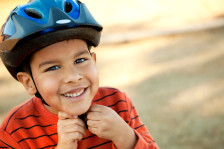Bike helmets for children and youth
When your child starts riding a bike, or taking part in any wheeled sports such as in-line skating, skateboarding, or riding a scooter, the most important safety measure you can take is to make sure they wear a helmet. The best way to encourage your child to wear a helmet is to wear one yourself.
Many children and teens are injured while riding a bike. While most injuries are broken bones, the most serious are ones that affect the head and brain.
In several provinces, anyone under the age of 18 must wear a certified helmet when cycling.
What kind of helmet does my child need?
Your child needs a helmet with an approved standards label. This label certifies that the helmet design has been tested by the manufacturer to protect your head. You can find the label inside or on the helmet.
Helmets sold in Canada are certified by CSA (Canadian Standards Association), CPSC (Consumer Product Safety Commission), Snell or ASTM (American Society for Testing and Materials).
A bike helmet is a single-impact helmet, which means that once it has been in a hard fall, it must be replaced.
How do I find the right helmet for my child?
- When you buy a helmet, take your child to the store so they can try on different ones.
- For the best protection, the helmet must fit properly and should be lightweight so your child’s head and neck can support it.
- The helmet should sit comfortably around your child’s head without falling over their ears and eyes. The distance between the front of the helmet and your child’s eyebrows should be two of his finger widths.
- The straps should go in front of and behind the ears, and fasten snugly under the chin.
- For an example of how a helmet should fit, see Parachute Canada.
Remember to check your child’s helmet at the beginning of every bike season to make sure it still fits properly.
Can I use a second-hand helmet?
Never use a second-hand helmet unless you know its history. It may have been in a crash, or you may not be able to tell how old it is. You should replace your child’s helmet when it’s older than 5 years, as the plastic becomes brittle with age.
Reviewed by the following CPS committees
- Injury Prevention Committee
Last updated: June 2018

